Subtracting Decimals
Let’s get straight to the point – learn how to subtract decimals with our easy guide.

Author
Jill Padfield
Published:
Oct 2024
Key takeaways
- Adding and subtracting decimals is a lot easier than you think – You’ll use the same subtraction skills you use to subtract whole numbers.
- Understanding how decimals work makes everything simpler – Once you understand the different parts of a decimal number, it’s pretty easy to visualize adding and subtracting them.
- Practice makes perfect – The more time you take to practice your subtraction skills, the better you’ll be when it comes to subtracting decimals.
Has your mom, dad, or guardian ever given you an allowance? Maybe they’ve offered to pay you ten dollars to do your chores. When you write ten dollars out, it looks like this:
$10.00
Now, if you stop doing your chores, your mom might threaten to decrease your allowance by $2.50. That means you need to figure out how much you’re going to be making, given this new, frustrating arrangement (side note: do your chores!).
Subtracting decimals is an important skill. It will help you save your money, figure out how much money you can spend, and more. Let’s dive into how to subtract decimals.
Adding and subtracting decimals, the rundown
It might look a little strange, but adding and subtracting decimals involves the same skills as finding the sum or the difference between two whole numbers.
First, always make sure that you put the number you start with on top and the number you are subtracting on the bottom.
Just like with normal addition and subtraction, you’ll want to arrange the equation vertically. This will make it easier to carry numbers and borrow numbers when you’re adding or subtracting.
Let’s see what that would look like.
You’re given two decimal numbers: 6.78 and 4.5.
So you will arrange them with the larger number on the top and the smaller number on the bottom.
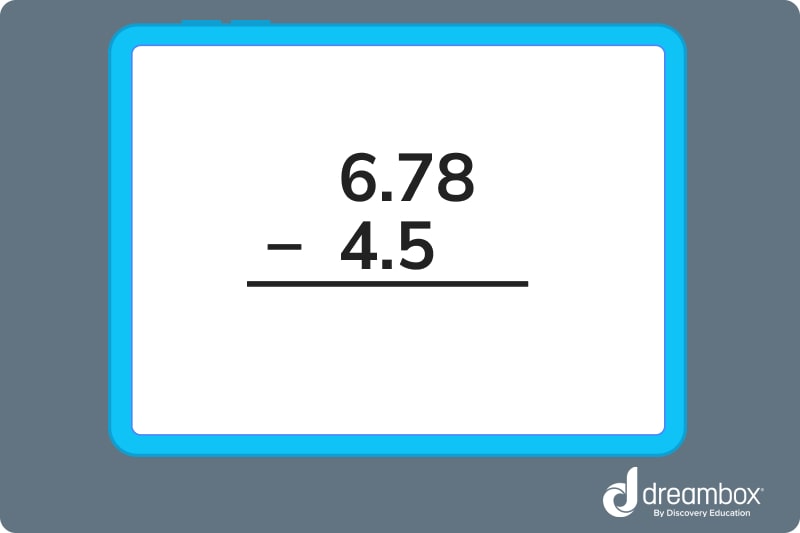
Now, you’re probably noticing that these numbers don’t match up. There isn’t a number underneath the 8 in 6.78. You need the decimals to match – what do you do?
Add a zero to the end of 4.5 so that the number becomes 4.50. Now, your equation looks like this:
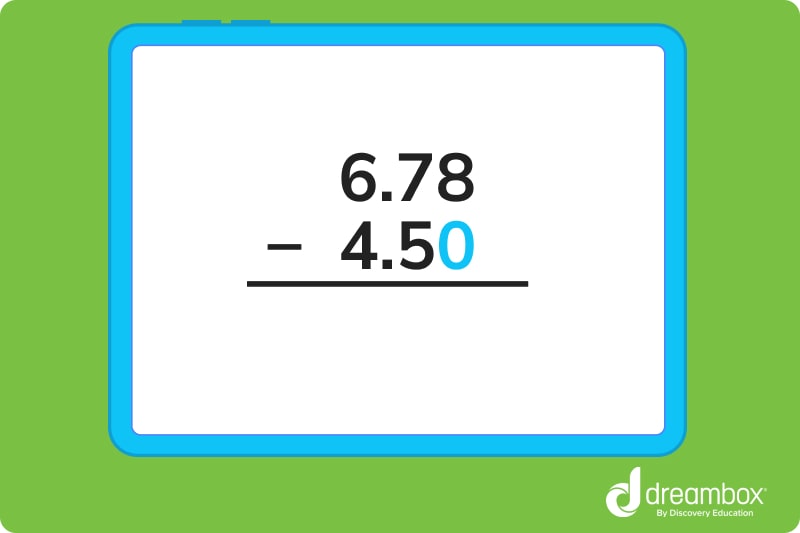
You’re ready to subtract!
Table of contents
Access more math practice with DreamBox
Turn math into playtime with DreamBox Math
DREAMBOX MATH
Get started for FREE today!

Important terms to know
It always helps to break things down into smaller pieces in order to understand the big picture. Let’s break that funky-looking number down a little bit. There are three terms you need to know in order to understand decimals:
- Decimal number – This is the entire figure you’re working with, including the whole number and the fractional part
- Whole number – This is the number to the left of the decimal point, the whole number
- Fractional part – This is the number or numbers to the right of the decimal point, representing a part of a whole number
It might help if we visualize this together. Let’s take a look at decimal number 4.56.
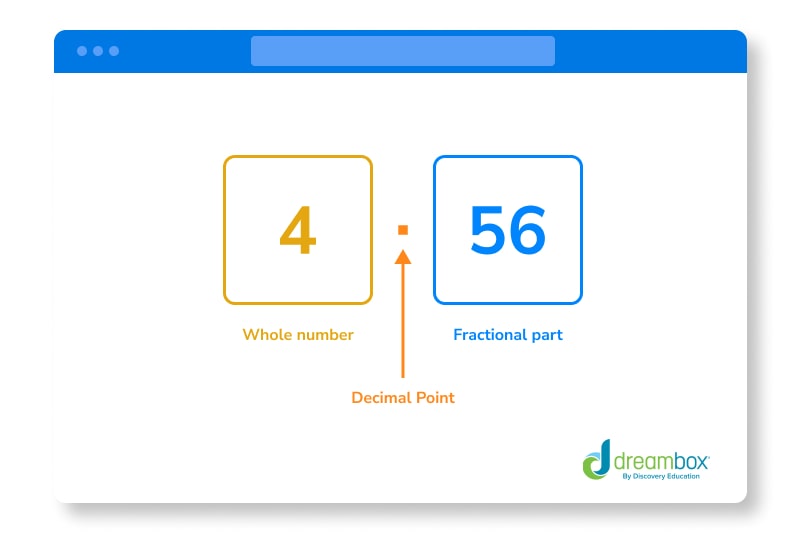
How to subtract decimals in 4 easy steps
Say we are given the following problem.
7.35 – 3.26
Let’s walk through a problem step-by-step to make sure we understand how to find the answer.
1. Arrange the problem vertically
Make sure you put the leading decimal number on top. It should look like this:
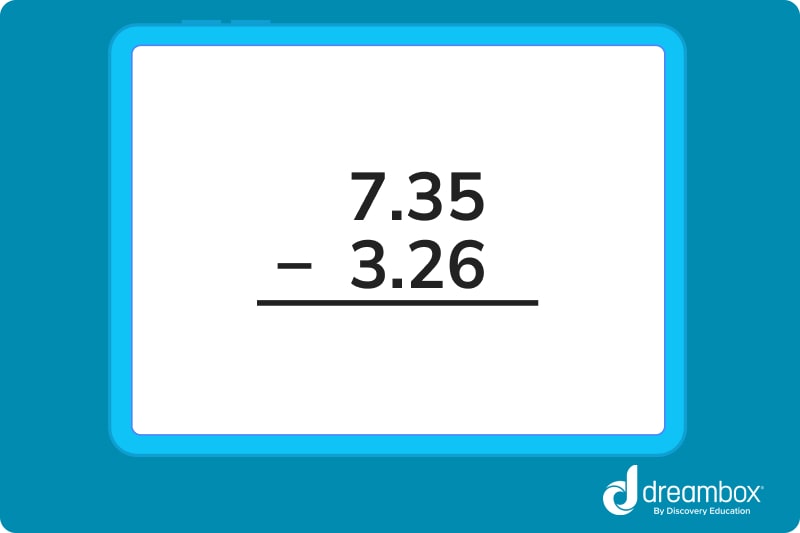
2. Borrow where you need to
Keep in mind that you can use place value to borrow numbers when you’re forced to subtract a larger number from a smaller one.
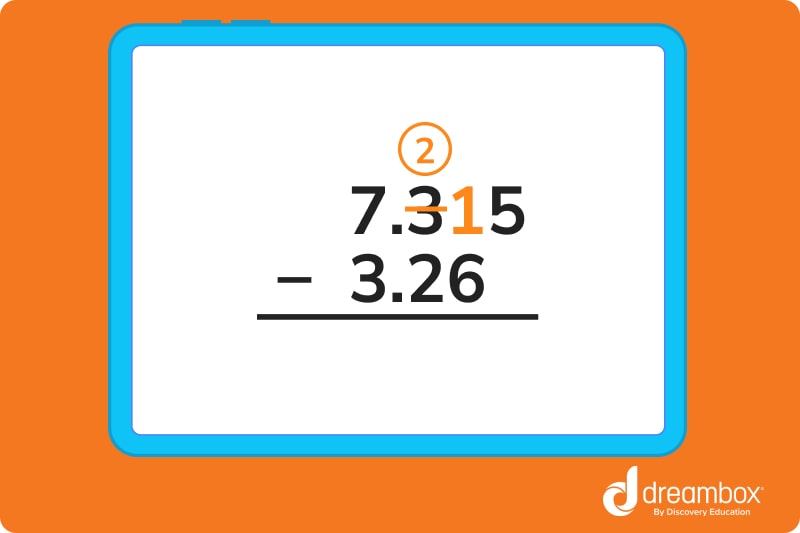
3. Subtract
Now that we’ve done our borrowing, we can start subtracting. It might be easiest for you to subtract one number from another at a time, then put the decimal number together at the end.
15 – 6 = 9. That means the second integer in the fractional number will be 9.
2 – 2 = 0. That means the first integer in the fractional number will be 0.
7 -3 = 4. So 4 is our whole number.
4. Put the decimal number together
Now that we’ve done our subtraction, we should have our answer:
7.35 – 3.26 = 4.09
But don’t forget, sometimes, you have to add a zero to a fractional part to make sure you can subtract.

The math program that drives results
Get started today!
DreamBox adapts to your child’s level and learning needs, ensuring they are appropriately challenged and get confidence-building wins.
Let’s practice together!
Before we set you off on your own path, let’s do a few practice problems together. Each are asking you to subtract decimals, but they’re worded a little differently to test your knowledge. Let’s get started.
1. Miguel has $12.56. He wants to buy a pack of gum for $1.50. How much will Miguel have left if he buys the gum?
Arrange the problem vertically first.
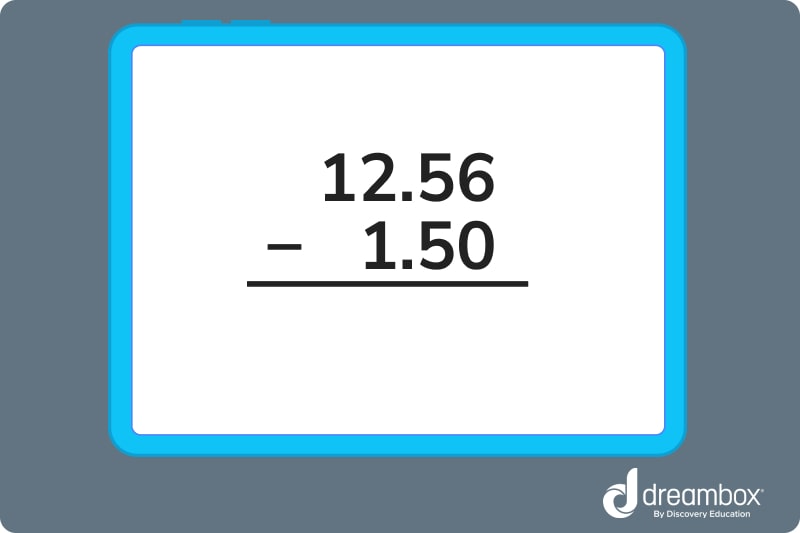
Then, start subtracting, borrowing if and when you need to (here, we don’t have to borrow at all!)
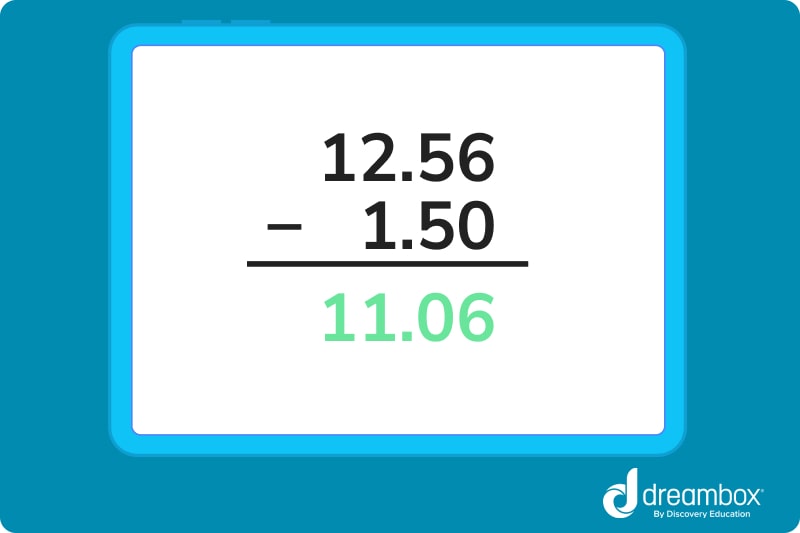
You’ve got your answer. Miguel will have $11.06 left if he buys the gum.
2. Solve the following: 7.8 - 5.69.
For this one, we’re going to have to make the decimals match up. Time to use our zeros!
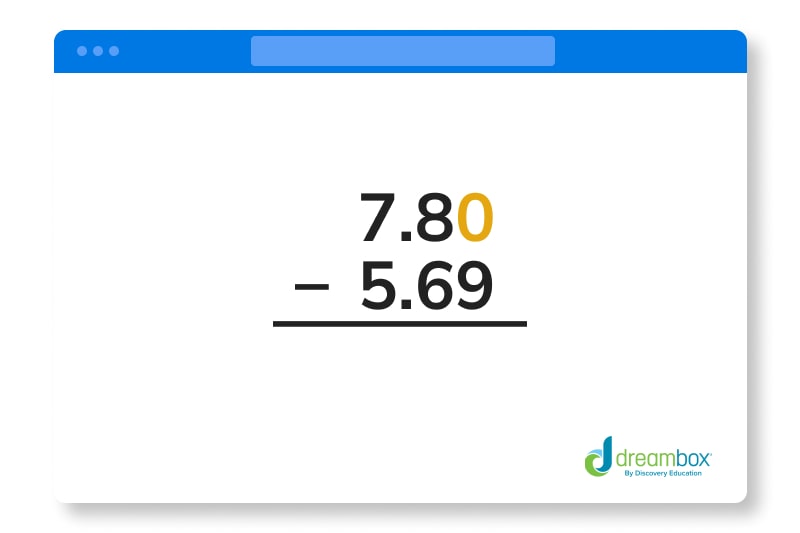
Then, we need to borrow, because we can’t subtract 9 from 0. Once we do that, we can do our subtraction.
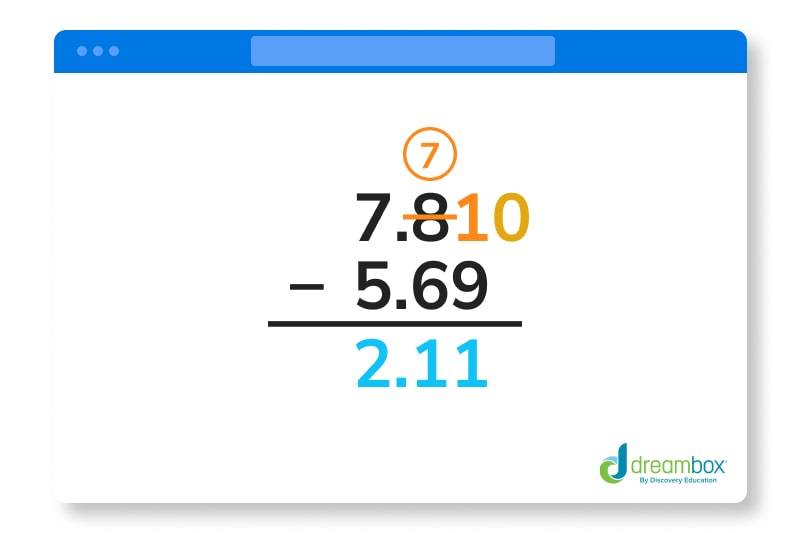
3. Emily has an 8 hour shift. She has worked 4.5 hours. How many more hours does Emily have left to work?
Once again, we have to use our zeros!
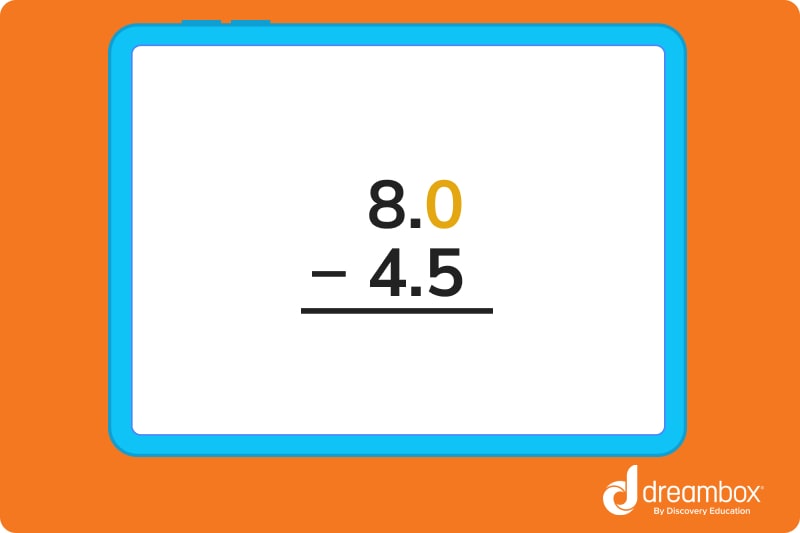
Then, we have to borrow.
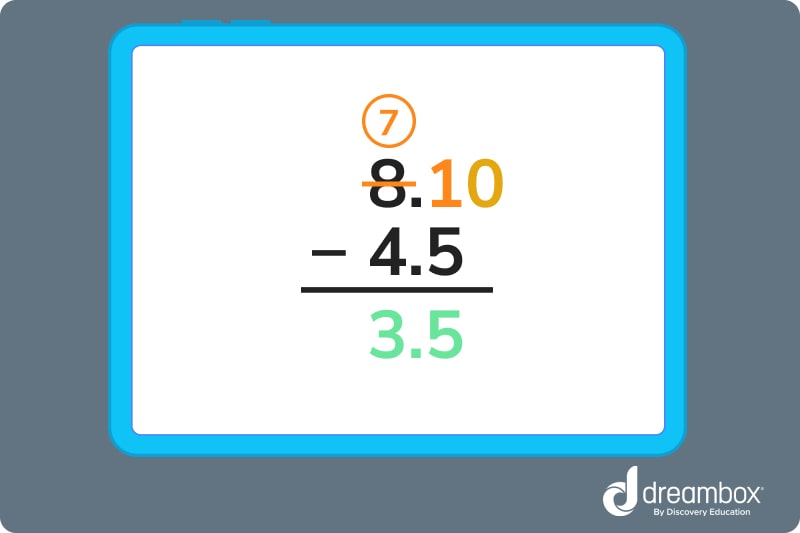
Emily has 3.5 hours left on her shift.
Ready to give it a go?
- Now it’s time for you to give a few of these problems a shot on your own. Feel free to consult the explanations, definitions, and practice problems above if you get confused or stumped on a question. And remember, practice makes perfect, so don’t get discouraged. Keep working through these problems and we promise you’ll get the hang of subtracting decimals in no time!
Practice Problems
The answer is 3.52.
The answer is $9.25.
The answer is 2.91.
The answer is 7.25 hours.
The answer is 2.78.
Parent Guide
1. The answer is 3.52.
How did we get here?
With this problem, you don’t have to borrow. Just have your student arrange the problem vertically, then subtract.
6.75
– 3.23
______
3.52
2. The answer is $9.25.
How did we get here?
1. Arrange the numbers vertically.
25.00
-15.75
2. Borrow, borrow, borrow.
12145.910 0100
15.75
3. Go one number at a time starting with the whole number and subtract.
So 10 – 5 = 5
9 – 7 = 2
14 – 5 = 9
1 – 1 = 0
4. Put it all together, and you get $9.25.
3. The answer is 2.91.
How did we get here?
1. Arrange the problem vertically.
5.62
-2.71
2. Borrow where appropriate.
45.1662
-2.71
3. Subtract the numbers.
2 – 1 = 1
16 – 7 = 9
4 – 2 = 2
4. Put it all together, you get 2.91.
4. The answer is 7.25 hours.
How did we get here?
1. Arrange vertically.
11.5
– 4.25
2. Add your zeros in.
11.50
– 4.25
3. Borrow where you need to.
11.45100
– 4.25
4. Subtract.
10 – 5 = 5
4 -2 = 2
11 – 4 = 7
5. Put it all together to get 7.25.
5. The answer is 2.78.
How did we get here?
1. Arrange vertically.
6.98
-4.2
2. Add in your zeros.
6.98
-4.20
3. Subtract.
6.98
-4.20
______
2.78
FAQs about math strategies for kids
There’s no single way to subtract decimals, but the first thing you want to do is line the numbers up vertically with the largest number on top and make sure the decimal points line up. Fill in any zeroes to make sure you have the same amount of numbers (so, for example, if you have 4.5 and 7.68, add a zero to 4.5 to make it 4.50). Then, subtract!
Decimals and fractions are simply two different ways to represent numbers. Fractions are written with the whole number in front and the fraction portion like A/B, with A representing part of the whole, B. Meanwhile, a decimal is written with the whole number to the left and the fractional part to the right.
So 4 ½ and 4.5 are the same number, written differently.
Yes you can! If you need to borrow in order to solve the problem, you can use that strategy to find the correct answer. It works the same way it does with double digit numbers that do not have decimals.
Take at home math practice to the next level
Empowering parents and educators to make math practice more impactful. Plus, your kids will love it.


About the Author
Jill Padfield
Jill Padfield has 7 years of experience teaching mathematics, ranging from Algebra 1 to Calculus. She is currently working as a Business Analyst, working to improve services for Veterans, while earning a masters degree in business administration.

